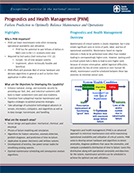
Failure Prediction to Optimally Balance Maintenance and Operations
Maintenance of critical systems is clearly important, but it also entails significant costs in terms of parts, labor, and loss of operational availability. Maintenance based on regular intervals is likely to be performed more often than needed leading to correspondingly higher costs. However, waiting until a critical system fails is likely to lead to even higher costs because of mission interruption, added logistical difficulties, and possibly the loss of entire systems or even human life. Ideally, maintenance could be scheduled between these two extremes to minimize overall costs. Prognostics and health management (PHM) is an advanced approach to minimize maintenance costs while maximizing operational availability and utilization of critical systems. PHM seeks to develop sensor hardware and algorithms to detect anomalies, diagnose problems that cause the anomalies, and compute a probability distribution of time to failure. Given this distribution along with operational constraints and objectives for the system, maintenance activities can be scheduled to achieve the optimal cost and utilization.
Why is PHM important?
- PHM can lower maintenance costs while increasing operational availability and utilization:
- PHM has the potential to save billions of dollars in maintenance and operation costs to the U.S. economy every year
- Required by DoD policy (DoD Instruction 4151.22):
- Include…for all new weapon systems
- Implement… where technically feasible and beneficial
- PHM efforts will promote R&D of sensor hardware and decision algorithms in general as well as further their application in other areas
What are the objectives for developing this capability?
- Enhance national, energy, and economic security by providing Department of Defense, Department of Energy, and industrial customers with tools to lower sustainment costs and raise readiness
- Transition from suboptimal reactive maintenance and logistics strategies to optimal proactive strategies
- Take advantage of cumulative technological advances in sensors, electronics, computers, and algorithms as well as in data storage, transmission, and handling
What are the research areas?
- Sensor design and application: mechanical, chemical, and electrical
- Physics of failure modeling and simulation
- Algorithms for feature extraction, anomaly detection, problem diagnosis, and prediction of time-to-failure
- Application to power electronics and military systems
- Development of wireless, low-power sensor nodes for retrofitting existing systems
- Optimal maintenance scheduling and consequence analysis algorithms
Fact Sheet

Click Fact Sheet to download PDF.